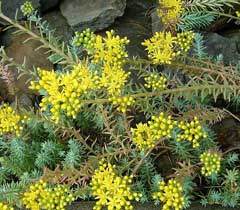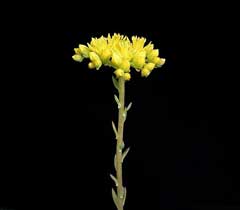 |
|
http://commons.wikimedia.org/wiki/User:Ies |
 |
| http://commons.wikimedia.org/wiki/User:Ies |
Translate this page:
Summary
Basionym of: Petrosedum rupestre (L.) P.V.Heath Sussex Cactus & Succ. Yearbook, 1987 (ed. P. Heath) 56. 1987
Physical Characteristics

 Sedum reflexum is an evergreen Perennial growing to 0.1 m (0ft 4in) by 0.3 m (1ft).
Sedum reflexum is an evergreen Perennial growing to 0.1 m (0ft 4in) by 0.3 m (1ft).
See above for USDA hardiness. It is hardy to UK zone 7 and is not frost tender. It is in flower from July to August, and the seeds ripen from August to September. The species is hermaphrodite (has both male and female organs) and is pollinated by Bees, flies, Lepidoptera (Moths & Butterflies). The plant is self-fertile.
Suitable for: light (sandy), medium (loamy) and heavy (clay) soils and prefers well-drained soil. Suitable pH: neutral and basic (mildly alkaline) soils. It can grow in semi-shade (light woodland) or no shade. It prefers dry or moist soil and can tolerate drought.
UK Hardiness Map
US Hardiness Map
Synonyms
Sedum reflexum L.
Plant Habitats
Edible Uses
Leaves - raw or cooked[4, 52, 115, 183]. A slightly astringent sour taste makes this plant a useful addition to a green tossed salad and it can also be added to soups or used as a vegetable[9, 183]. Used in salads, it has a fine relish[2].
References More on Edible Uses
Medicinal Uses
Plants For A Future can not take any responsibility for any adverse effects from the use of plants. Always seek advice from a professional before using a plant medicinally.
None known
References More on Medicinal Uses
The Bookshop: Edible Plant Books
Our Latest books on Perennial Plants For Food Forests and Permaculture Gardens in paperback or digital formats.

Edible Tropical Plants
Food Forest Plants for Hotter Conditions: 250+ Plants For Tropical Food Forests & Permaculture Gardens.
More

Edible Temperate Plants
Plants for Your Food Forest: 500 Plants for Temperate Food Forests & Permaculture Gardens.
More

More Books
PFAF have eight books available in paperback and digital formats. Browse the shop for more information.
Shop Now
Other Uses
Agroforestry Uses:
A good ground cover plant for a sunny position[188
]. The somewhat open growth habit makes it suitable for growing with larger bulbs such as some lilies[K
]. Place starter plants 20 - 30cm apart in order to obtain rapid massing as a ground cover[352
].
The plant is used on 'green roof' and 'green wall' systems in Korea. These systems are incorporated into the structure of the building, providing habitats for wildlife as well as insulating the building and helping to improve the environment. The cultivar 'Blue Spruce' has been specifically mentioned[1240
, 1241
]
Special Uses
References More on Other Uses
Cultivation details
Succeeds in most soils[188] but prefers a fertile well-drained soil[200]. Requires a sunny position[188, 200]. The plant flowers best when grown in a sunny position, though it also succeeds in semi-shade[219]. Established plants are very drought tolerant[200], they grow well in dry soils and can also be grown in a crevice on a wall[200, 219]. This species is hardy to about -15°c[200]. A mat forming plant, it spreads rapidly and it is not suitable for the rockery[83]. All members of this genus are said to have edible leaves, though those species, such as this one, that have yellow flowers can cause stomach upsets if they are eaten in quantity[62, 85]. Plants in this genus seem to be immune to the predations of rabbits[233]. The plant is heat tolerant in zones 9 through 6. (Plant Hardiness Zones show how well plants withstand cold winter temperatures.
Plant Heat Zones show when plants would start suffering from the heat.
The Plant Heat Zone map is based on the number of "heat days" experienced in a given area where the temperature climbs to over 86 degrees F (30°C).
At this temperature, many plants begin to suffer physiological damage. Heat Zones range from 1 (no heat days) to 12 (210 or more heat days).
For example Heat Zone. 11-1 indicates that the plant is heat tolerant in zones 11 through 1.) For polyculture design as well as the above-ground architecture (form - tree, shrub etc. and size shown above) information on the habit and root pattern is also useful and given here if available. An evergreen. The plant growth habit is a runner spreading indefinitely by rhizomes or stolons [1-2].
References Carbon Farming Information and Carbon Sequestration Information
Temperature Converter
Type a value in the Celsius field to convert the value to Fahrenheit:
Fahrenheit:
The PFAF Bookshop
Plants For A Future have a number of books available in paperback and digital form. Book titles include Edible Plants, Edible Perennials, Edible Trees,Edible Shrubs, Woodland Gardening, and Temperate Food Forest Plants. Our new book is Food Forest Plants For Hotter Conditions (Tropical and Sub-Tropical).
Shop Now
Plant Propagation
Seed - surface sow in spring in well-drained soil in a sunny position in a greenhouse. Do not allow the soil to dry out. Prick out the seedlings into individual pots when they are large enough to handle. If sufficient growth is made, it is possible to plant them out during the summer, otherwise keep them in a cold-frame or greenhouse for their first winter and plant them out in early summer of the following year[K]. Division is very easy and can be carried out at almost any time in the growing season, though is probably best done in spring or early summer. Larger divisions can be planted out direct into their permanent positions. We have found it best to pot up the smaller divisions and grow them on in a lightly shaded position in a cold frame, planting them out once they are well established in the summer.
Other Names
If available other names are mentioned here
Native Range
TEMPERATE ASIA: Ciscaucasia,Russian Federation-Ciscaucasia. EUROPE: Denmark, Finland, Norway, Sweden, Austria, Belgium, Switzerland, Czech Republic, Germany, Hungary, Netherlands, Poland, Slovakia, Ukraine, Albania, Bosnia and Herzegovina, Greece, Croatia, Italy (incl. Sardinia, Sicily), North Macedonia, Romania, Serbia, Slovenia, Spain, France,
Weed Potential
Right plant wrong place. We are currently updating this section.
Please note that a plant may be invasive in one area but may not in your area so it's worth checking.
Conservation Status
IUCN Red List of Threatened Plants Status :

| Related Plants
|
| Latin Name | Common Name | Habit | Height | Hardiness | Growth | Soil | Shade | Moisture | Edible | Medicinal | Other |
| Sedum acre | Common Stonecrop, Goldmoss stonecrop, Gold Moss Sedum | Perennial | 0.1 |
4-9
| F | LMH | N | DM | 1 | 2 | 3 |
| Sedum aizoon | Sedum | Perennial | 0.4 |
4-10
| M | LMH | N | DM | 1 | 1 | |
| Sedum album | Small Houseleek, White stonecrop, Sedum, Stonecrop | Perennial | 0.1 |
6-8
| M | LMH | N | DM | 1 | 1 | 3 |
| Sedum anacampseros | Loce Restorer | Perennial | 0.1 |
5-9
| | LMH | SN | DM | 1 | 0 | 3 |
| Sedum arboroseum | Garden Stonecrop | Perennial | 0.5 |
5-9
| | LMH | SN | DM | 1 | 2 | |
| Sedum divergens | Pacific Stonecrop | Perennial | 0.2 |
5-9
| | LMH | N | DM | 1 | 1 | |
| Sedum forsterianum | Stonecrop | Perennial | 0.2 |
6-9
| | LMH | N | DM | 1 | 0 | |
| Sedum japonicum | | Perennial | 0.2 |
-
| | LMH | N | DM | 1 | 0 | |
| Sedum kamtschaticum | Orange stonecrop, Kamschataka Sedum, Kamschataka Stonecrop | Perennial | 0.1 |
4-10
| M | LMH | N | DM | 1 | 2 | 2 |
| Sedum lanceolatum | Spearleaf Stonecrop, Subalpine stonecrop | Perennial | 0.2 |
5-9
| | LMH | N | DM | 1 | 1 | |
| Sedum lineare | Needle stonecrop | Perennial | 0.3 |
6-9
| | LMH | N | DM | 1 | 1 | |
| Sedum makinoi | Stonecrop, Sedum | Perennial | 0.2 |
8-10
| M | LMH | N | DM | 1 | 2 | |
| Sedum oreganum | Oregon stonecrop | Perennial | 0.2 |
5-9
| | LMH | N | DM | 1 | 0 | 2 |
| Sedum rupestre | Crooked Yellow Stonecrop | Perennial | 0.1 |
6-9
| | LMH | SN | DM | 1 | 0 | 2 |
| Sedum sarmentosum | stringy stonecrop | Perennial | 0.1 |
6-9
| | LMH | N | DM | 1 | 1 | |
| Sedum sediforme | | Perennial | 0.5 |
7-10
| | LMH | N | M | 1 | 0 | |
| Sedum spathulifolium | Broadleaf Stonecrop, Purdy's stonecrop, Yosemite stonecrop, Stonecrop, Blood Leaf Sedum | Perennial | 0.1 |
6-10
| M | LMH | SN | DM | 1 | 1 | 3 |
| Sedum spectabile | Ice Plant | Perennial | 0.4 |
5-9
| | LMH | N | DM | 2 | 1 | 3 |
| Sedum spurium | Caucasian Stonecrop | Perennial | 0.2 |
6-9
| | LMH | N | DM | 1 | 0 | 3 |
| Sedum stenopetalum | Wormleaf Stonecrop | Perennial | 0.2 |
5-9
| | LMH | N | DM | 1 | 1 | |
| Sedum stoloniferum | Stolon stonecrop, Sedum | Perennial | 0.2 |
7-9
| M | LMH | N | DM | 1 | 0 | |
| Sedum telephium | Orpine | Perennial | 0.5 |
4-8
| | LMH | FSN | DM | 1 | 2 | |
| Sedum ternatum | Woodland stonecrop or Wild stonecrop | Perennial | 0.2 |
3-9
| M | LMH | FSN | DM | 2 | 0 | 2 |
|
Growth: S = slow M = medium F = fast. Soil: L = light (sandy) M = medium H = heavy (clay). pH: A = acid N = neutral B = basic (alkaline). Shade: F = full shade S = semi-shade N = no shade. Moisture: D = dry M = Moist We = wet Wa = water.
Now available:
Food Forest Plants for Mediterranean Conditions
350+ Perennial Plants For Mediterranean and Drier Food Forests and Permaculture Gardens.
[Paperback and eBook]
This is the third in Plants For A Future's series of plant guides for food forests tailored to
specific climate zones. Following volumes on temperate and tropical ecosystems, this book focuses
on species suited to Mediterranean conditions—regions with hot, dry summers and cool, wet winters,
often facing the added challenge of climate change.
Read More
Expert comment
Author
L.
Botanical References
17200
Links / References
For a list of references used on this page please go here
Readers comment
| Add a comment |
|
If you have important information about this plant that may help other users please add a comment or link below. Only comments or links that are felt to be directly relevant to a plant will be included. If you think a comment/link or information contained on this page is inaccurate or misleading we would welcome your feedback at [email protected]. If you have questions about a plant please use the Forum on this website as we do not have the resources to answer questions ourselves.
* Please note: the comments by website users are not necessarily those held by PFAF and may give misleading or inaccurate information.
To leave a comment please Register or login here All comments need to be approved so will not appear immediately.
|
|